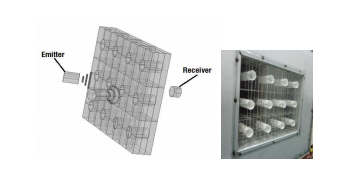Via MIT Technology Review
-----
By exploiting some exotic acoustic techniques, researchers have built a window that allows the passage of air but not sound

Noise pollution is one of the bugbears of modern life. The sound of machinery, engines, neighbours and the like can seriously affect our quality of life and that of the other creatures that share this planet.
But insulating against sound is a difficult and expensive business. Soundproofing generally works on the principle of transferring sound from the air into another medium which absorbs and attenuates it.
So the notion of creating a barrier that absorbs sound while allowing the free of passage of air seems, at first thought, entirely impossible. But that’s exactly what Sang-Hoon Kima at the Mokpo National Maritime University in South Korea and Seong-Hyun Lee at the Korea Institute of Machinery and Materials, have achieved.
These guys have come up with a way to separate sound from the air in which it travels and then to attenuate it. This has allowed them to build a window that allows air to flow but not sound.
The design is relatively simple and relies on two exotic acoustic phenomenon. The first is to create a material with a negative bulk modulus.
A material’s bulk modulus is essentially its resistance to compression and this is an important factor in determining the speed at which sound moves through it. A material with a negative bulk modulus exponentially attenuates any sound passing through it.
However, it’s hard to imagine a solid material having a negative bulk modulus, which is where a bit of clever design comes in handy.
Kima and Lee’s idea is to design a sound resonance chamber in which the resonant forces oppose any compression. With careful design, this leads to a negative bulk modulus for a certain range of frequencies.
Their resonance chamber is actually very simple—it consists of two parallel plates of transparent acrylic plastic about 150 millimetres square and separated by 40 millimetres, rather like a section of double-glazing about the size of a paperback book.
This chamber is designed to ensure that any sound resonating inside it acts against the way the same sound compresses the chamber. When this happens the bulk modulus of the entire chamber is negative.
An important factor in this is how efficiently the sound can get into the chamber and here Kima and Lee have another trick. To maximise this efficiency, they drill a 50 millimetre hole through each piece of acrylic. This acts as a diffraction element causing any sound that hits the chamber to diffract strongly into it.
The result is a double-glazed window with a negative bulk modulus that strongly attenuates the sound hitting it.
Kima and Lee use their double-glazing unit as a building block to create larger windows. In tests with a 3x4x3 “wall” of building blocks, they say their window reduces sound levels by 20-35 decibels over a sound range of 700 Hz to 2,200 Hz. That’s a significant reduction.
And by using extra building blocks with smaller holes, they can extend this range to cover lower frequencies.
What’s handy about these windows is that holes through them also allow the free flow of air, giving ample ventilation as well.
The applications are many. Changing the size of the holes makes the windows tunable so they screen out only certain frequencies, the new designs have some interesting applications.
“For example, if we are in a combined area of sounds from sea waves of low frequency and noises from machine operating at a high frequency, we can hear only the sounds from sea waves with fresh air,” say Kima and Lee.
What’s more, they say the same idea should also work in water which could help in applications such as protecting marine animals from noise pollution.
A clever idea that tackles one of the increasingly common problems of modern living.
Ref: arxiv.org/abs/1307.0301: Air Transparent Soundproof Window.

